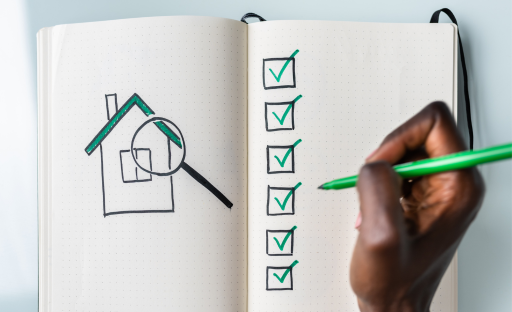The ultimate new build snagging checklist for homeowners
Navigating the world of new home ownership can be an exhilarating yet daunting journey. With the excitement of a fresh start comes the responsibility to ensure that every aspect of your newly built property is up to par. This involves not just appreciating its aesthetic appeal, but also meticulously inspecting for any potential issues or ‘snags’ that may have been overlooked during construction.
In this comprehensive guide, we delve into crucial aspects you need to consider when scrutinizing your new property – from understanding why a detailed inspection list is indispensable for homeowners, offering practical advice on how to create one effectively, highlighting common oversights often missed in inspections and providing tips on how best to avoid them.
Our aim? To equip you with all the necessary knowledge and tools needed for this critical task. So whether you’re stepping onto the property ladder for the first time or are an experienced homeowner looking at a brand-new build, read on as we unravel these key insights together.
When embarking on the journey of owning a new build home, it’s crucial to ensure that everything is in order. This process involves conducting a thorough snagging inspection before settling into your new abode. A snagging list refers to an inventory of all the minor issues or ‘snags’ found in a newly constructed property that needs rectifying by the builder or developer.
The first step towards creating an effective snagging checklist is focusing on structural elements. Check for any visible defects such as cracks in walls and ceilings, misaligned doors and windows, uneven surfaces, poor plastering quality or paintwork inconsistencies. Plumbing should be thoroughly inspected for leaks while electrical systems must be tested for safety and functionality – this includes sockets, switches and light fixtures among others. Heating systems should not only function correctly but also provide adequate coverage throughout the house; cold spots may indicate insulation issues.
In addition to these major areas of concern are finer details often overlooked yet equally important when ensuring your home’s long-term comfortability and value retention: kitchen units should align properly with no gaps; bathroom fittings ought to be secure without loose tiles; flooring needs careful examination for squeaks or movement underfoot which could suggest subfloor problems; even garden landscaping requires scrutiny – poorly laid turf can lead to water pooling causing potential damage over time.
Remember that while some snags might seem insignificant at first glance they could potentially escalate into serious problems if left unaddressed so it’s always better being proactive rather than reactive when dealing with new build properties.
Key Elements to Consider in Your New Build Snagging Checklist

When it comes to new builds, snagging is an essential part of the process. It’s important for homeowners to be aware of what needs to be checked and how best to go about it. To help you out, we’ve put together a comprehensive checklist that covers all the key elements you should consider when snagging your new build property.
First and foremost, check for any visible defects in the construction work itself – this includes walls, ceilings, windows and doors as well as flooring and tiling. Make sure everything looks right from top-to-bottom; if there are any cracks or gaps then these need addressing immediately before they get worse over time. Additionally, take note of any areas where paintwork may have been missed or not applied correctly – this could lead to long term issues down the line so ensure that everything looks neat and tidy throughout your home!
Next up on our list is electrical safety checks – make sure all sockets are secure with no exposed wires present; test each one individually using a voltage meter (or hire someone who can do this professionally). Also keep an eye out for smoke alarms which must be installed in accordance with building regulations; if they aren’t present then contact your builder straight away! Finally don’t forget about gas safety too – ensure that all appliances have been serviced by a qualified engineer prior to moving into your home as per legal requirements.
Finally look at general maintenance items such as checking gutters/downpipes are clear from debris (which could cause flooding) plus looking at external lighting fixtures which should also be working properly upon completion of works – again contact your builder if anything isn’t quite right here either! All these points combined will give you peace of mind knowing that nothing has been overlooked during construction phase so don’t hesitate when it comes time for snagging inspections – make sure every detail has been taken care off before signing off on completion paperwork!
Understanding the Importance of a Comprehensive Snagging List for Homeowners

As a homeowner, it is important to understand the importance of having a comprehensive snagging list. A snagging list is an essential document that outlines any defects or incomplete works in your new build property. It should be completed before you move into your home and can help ensure that all necessary repairs are made prior to occupancy.
Having a detailed and accurate snagging list will not only protect you from potential issues down the line but also provide peace of mind when moving into your new home. The most common items on a snagging list include problems with plumbing, electrical wiring, flooring, walls and ceilings as well as any other structural issues such as cracks or dampness in the building fabric.
It’s important to note that some minor cosmetic defects may not be included on the original builder’s checklist so it’s always worth double-checking for yourself during viewings before signing off on completion paperwork. If there are any discrepancies between what was promised by the builder and what has been delivered then this should be noted too – this could save you time and money further down the line if these issues aren’t addressed at an early stage!
By having an up-to-date understanding of exactly what needs to be done in order for your property to meet its full potential means you can rest assured knowing everything has been taken care of prior to moving day – giving you one less thing to worry about!
Tips on Creating an Effective New Build Snagging Checklist

Creating an effective new build snagging checklist is essential for homeowners who want to ensure their property is up to standard and free of any defects. A good snagging list should include all the details that need to be checked, from major structural elements such as walls and ceilings, down to minor issues like paintwork or loose tiles.
To create a comprehensive checklist, start by making a note of any concerns you have about your home before you move in. This could include anything from visible cracks in the walls or ceiling, damp patches on the flooring or windows that don’t open properly. Once you have identified these potential problems it’s time to get more detailed with your inspection.
The next step is to inspect each room thoroughly for any signs of damage or unfinished workmanship; this includes checking doors and windows are fitted correctly, looking at skirting boards for gaps between them and the wall surface as well as inspecting light fittings and plug sockets for correct installation. It’s also important not forget about outside areas too – check fences are secure, paths are level without trip hazards present etc..
Once you have inspected every area inside (and outside) your home make sure all items on your list are recorded accurately so there can be no confusion when it comes time for repairs/corrections later down the line – if possible take photos too! Finally go through everything one last time with a fine-tooth comb before signing off on completion – this way nothing will slip through unnoticed!
Common Oversights: What Often Gets Missed in a New Build Snagging List?

When it comes to new builds, snagging lists are essential for ensuring that the property is up to standard and free of any defects. However, there are some common oversights which can often be missed in a snagging list.
One of the most overlooked areas is drainage and water supply systems. It’s important to check these thoroughly as any issues could cause significant damage if left unchecked. This includes checking for leaks or blockages in pipes, testing taps and showers for pressure levels, inspecting gutters and downpipes for signs of wear or damage, as well as checking all appliances such as washing machines and dishwashers are installed correctly with no visible faults or leaks present.
Another area which should not be forgotten when creating a snagging list is electrical safety checks; this includes making sure all wiring has been installed properly with no exposed wires present along with ensuring that all sockets have been fitted securely into walls without any loose connections visible. Additionally you should also check light switches throughout the house work correctly including dimmers where applicable – don’t forget those hard-to-reach places like cupboards!

Finally it’s important to look out for cosmetic issues such as chipped paintwork on door frames or skirting boards; while these may seem minor they can still affect how your home looks overall so make sure you take note of anything that needs attention before signing off on your new build project!
How do you make a snag list in construction?
To create a snag list in construction, conduct a thorough inspection of the completed project, identifying any defects, deficiencies, or issues that need rectification. Document each snag with specific details, including location, description, and supporting evidence such as photographs. Categorize the snags based on type or responsible party, and prioritize them according to urgency and impact. Compile the information into a formal snag list report, including project details, date of inspection, and assigned priorities. Share the report with relevant stakeholders and monitor the progress of snag rectifications, conducting a re-inspection before final project handover to ensure all issues have been addressed.
homes snagging checklist
Exterior
Check the brickwork for any cracks or unevenness.
Ensure the pointing is neat and consistent.
Check the roof tiles for any damage or missing pieces.
Check the guttering and drainpipes for secure fitting.
Ensure the windows and doors are aligned properly and open/close smoothly.
Check the garden, fences, and gates for any damage or poor installation.
Interior
Check the walls and ceilings for cracks, holes, or poor paintwork.
Ensure all light switches and electrical sockets work.
Check the flooring for any damage or unevenness.
Ensure all doors open/close smoothly and locks work properly.
Check the stairs for any instability or creaking.
Kitchen
Check all the cabinets for proper alignment and smooth operation.
Ensure the worktops are secure and undamaged.
Check the sink, taps, and plumbing for any leaks.
Ensure all appliances are in working order.
Bathroom
Check the bath, shower, sink, and toilet for any leaks or damage.
Ensure the tiles are laid properly with no cracks or unevenness.
Check the sealant around the bath, shower, sink, and toilet.
Heating
Ensure the radiators heat up evenly and are securely attached to the walls.
Check the boiler is in working order and has been serviced.
Electrical
Check the fuse box is clearly labelled and accessible.
Ensure all lights are working.
Check all sockets with a socket tester.
Plumbing
Check all taps for leaks or drips.
Ensure the water pressure is adequate.
Check the hot water temperature.







One Response
Fantastic and very useful!